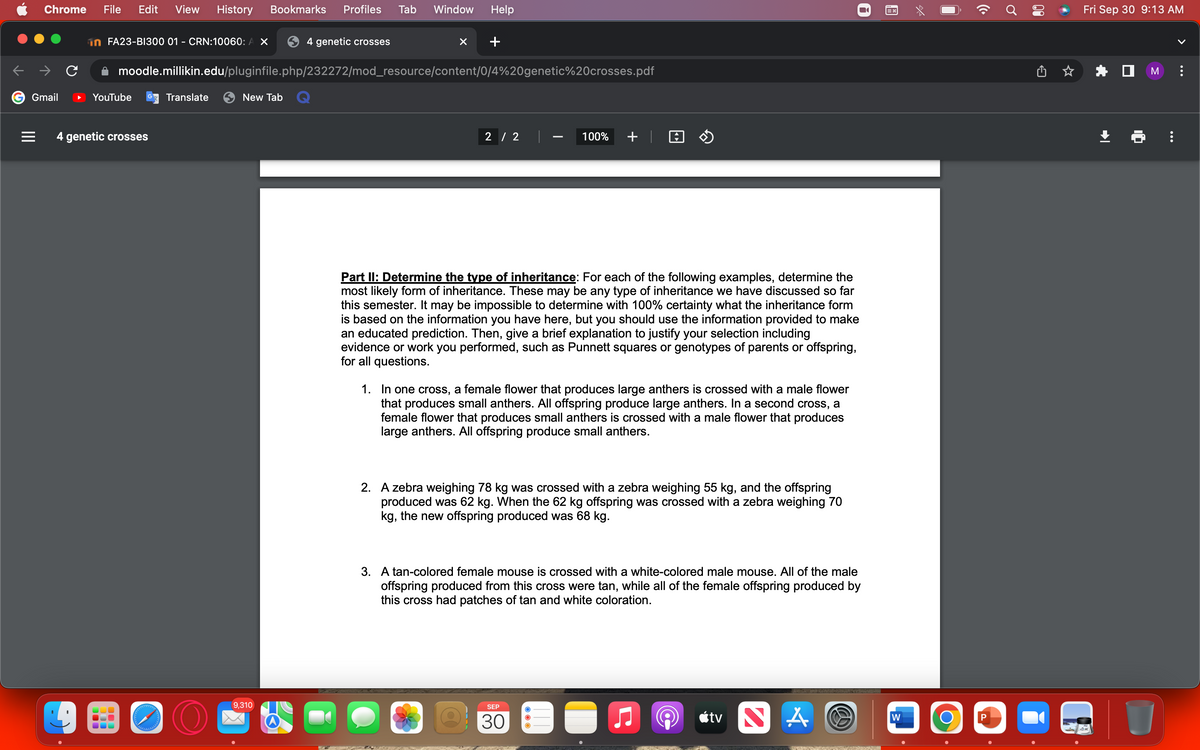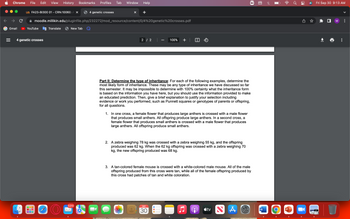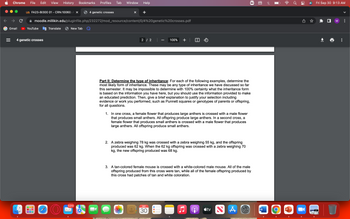Part II: Determine the type of inheritance: For each of the following examples, determine the most likely form of inheritance. These may be any type of inheritance we have discussed so far this semester. It may be impossible to determine with 100% certainty what the inheritance form is based on the information you have here, but you should use the information provided to make an educated prediction. Then, give a brief explanation to justify your selection including evidence or work you performed, such as Punnett squares or genotypes of parents or offspring, for all questions. 1. In one cross, a female flower that produces large anthers is crossed with a male flower that produces small anthers. All offspring produce large anthers. In a second cross, a female flower that produces small anthers is crossed with a male flower that produces large anthers. All offspring produce small anthers.
Part II: Determine the type of inheritance: For each of the following examples, determine the most likely form of inheritance. These may be any type of inheritance we have discussed so far this semester. It may be impossible to determine with 100% certainty what the inheritance form is based on the information you have here, but you should use the information provided to make an educated prediction. Then, give a brief explanation to justify your selection including evidence or work you performed, such as Punnett squares or genotypes of parents or offspring, for all questions. 1. In one cross, a female flower that produces large anthers is crossed with a male flower that produces small anthers. All offspring produce large anthers. In a second cross, a female flower that produces small anthers is crossed with a male flower that produces large anthers. All offspring produce small anthers.
Concepts of Biology
1st Edition
ISBN:9781938168116
Author:Samantha Fowler, Rebecca Roush, James Wise
Publisher:Samantha Fowler, Rebecca Roush, James Wise
Chapter8: Patterns Of Inheritance
Section: Chapter Questions
Problem 2ACQ: Figure 8.10 In pea plants, purple flowers (P) are dominant to white (p), and yellow peas (Y) are...
Related questions
Topic Video
Question
#1 please

Transcribed Image Text:Chrome File Edit View History Bookmarks Profiles Tab Window Help
Gmail
с
in FA23-B1300 01 - CRN:10060: A X
YouTube
4 genetic crosses
moodle.millikin.edu/pluginfile.php/232272/mod_resource/content/0/4%20genetic%20crosses.pdf
Translate
O
New Tab
4 genetic crosses
9,310
X
+
2 / 2
100% +
Part II: Determine the type of inheritance: For each of the following examples, determine the
most likely form of inheritance. These may be any type of inheritance we have discussed so far
this semester. It may be impossible to determine with 100% certainty what the inheritance form
is based on the information you have here, but you should use the information provided to make
an educated prediction. Then, give a brief explanation to justify your selection including
evidence or work you performed, such as Punnett squares or genotypes of parents or offspring,
for all questions.
1. In one cross, a female flower that produces large anthers is crossed with a male flower
that produces small anthers. All offspring produce large anthers. In a second cross, a
female flower that produces small anthers is crossed with a male flower that produces
large anthers. All offspring produce small anthers.
2. A zebra weighing 78 kg was crossed with a zebra weighing 55 kg, and the offspring
produced was 62 kg. When the 62 kg offspring was crossed with a zebra weighing 70
kg, the new offspring produced was 68 kg.
SEP
30
3. A tan-colored female mouse is crossed with a white-colored male mouse. All of the male
offspring produced from this cross were tan, while all of the female offspring produced by
this cross had patches of tan and white coloration.
i
tv
A Ⓡ
=
W
80
Fri Sep 30 9:13 AM
☐M
:
Expert Solution
This question has been solved!
Explore an expertly crafted, step-by-step solution for a thorough understanding of key concepts.
This is a popular solution!
Trending now
This is a popular solution!
Step by step
Solved in 2 steps

Follow-up Questions
Read through expert solutions to related follow-up questions below.
Follow-up Question
#2 please

Transcribed Image Text:Chrome File Edit View History Bookmarks Profiles Tab Window Help
Gmail
с
Answered: Part II: Determine th X in FA23-B1300 01 - CRN:10060: A X
moodle.millikin.edu/pluginfile.php/232272/mod_resource/content/0/4%20genetic%20crosses.pdf
YouTube
4 genetic crosses
Translate
O
New Tab
9,310
4 genetic crosses
2/2
100% + |
3. A tan-colored female mouse is crossed with a white-colored male mouse. All of the male
offspring produced from this cross were tan, while all of the female offspring produced by
this cross had patches of tan and white coloration.
Part III: Practice with non-Mendelian inheritance patterns: Answer each question about the
results of each cross below. Include any work you performed to explain your answers.
1. The body-cover trait displays an extranuclear maternal inheritance pattern. The alleles
for this trait can be either Smooth or Bumpy, with organisms that are heteroplasmic
displaying a Wavy phenotype. What would be the expected phenotypes of offspring for
the following crosses? You do not need to report the expected ratio of each phenotype,
just which phenotypes could occur.
a. Smooth male x Bumpy female
b. Smooth male x Wavy female
c. Wavy male x Smooth female
OCT
2
2. A maternal effect gene exists with a dominant N allele and a recessive n allele. What
would the phenotypic ratio and genotypic ratio of offspring be for the following crosses?
a. nn female x NN male
b. NN female x nn male
c. Nn female x Nn male
tv NA
P
((.
O
W
ດາ
Sun Oct 2 2:34 PM
☐M :
Solution
Follow-up Question
#1 please

Transcribed Image Text:Chrome File Edit View History Bookmarks Profiles Tab Window Help
Gmail
с
Answered: Part II: Determine th X in FA23-B1300 01 - CRN:10060: A X
moodle.millikin.edu/pluginfile.php/232272/mod_resource/content/0/4%20genetic%20crosses.pdf
YouTube
4 genetic crosses
Translate
O
New Tab
9,310
4 genetic crosses
2/2
100% + |
3. A tan-colored female mouse is crossed with a white-colored male mouse. All of the male
offspring produced from this cross were tan, while all of the female offspring produced by
this cross had patches of tan and white coloration.
Part III: Practice with non-Mendelian inheritance patterns: Answer each question about the
results of each cross below. Include any work you performed to explain your answers.
1. The body-cover trait displays an extranuclear maternal inheritance pattern. The alleles
for this trait can be either Smooth or Bumpy, with organisms that are heteroplasmic
displaying a Wavy phenotype. What would be the expected phenotypes of offspring for
the following crosses? You do not need to report the expected ratio of each phenotype,
just which phenotypes could occur.
a. Smooth male x Bumpy female
b. Smooth male x Wavy female
c. Wavy male x Smooth female
OCT
2
2. A maternal effect gene exists with a dominant N allele and a recessive n allele. What
would the phenotypic ratio and genotypic ratio of offspring be for the following crosses?
a. nn female x NN male
b. NN female x nn male
c. Nn female x Nn male
tv NA
P
((.
O
W
ດາ
Sun Oct 2 2:34 PM
☐M :
Solution
Follow-up Question
#3 please

Transcribed Image Text:Chrome File Edit View History Bookmarks Profiles Tab Window Help
Gmail
с
in FA23-B1300 01 - CRN:10060: A X
YouTube
4 genetic crosses
moodle.millikin.edu/pluginfile.php/232272/mod_resource/content/0/4%20genetic%20crosses.pdf
Translate
O
New Tab
4 genetic crosses
9,310
X
+
2 / 2
100% +
Part II: Determine the type of inheritance: For each of the following examples, determine the
most likely form of inheritance. These may be any type of inheritance we have discussed so far
this semester. It may be impossible to determine with 100% certainty what the inheritance form
is based on the information you have here, but you should use the information provided to make
an educated prediction. Then, give a brief explanation to justify your selection including
evidence or work you performed, such as Punnett squares or genotypes of parents or offspring,
for all questions.
1. In one cross, a female flower that produces large anthers is crossed with a male flower
that produces small anthers. All offspring produce large anthers. In a second cross, a
female flower that produces small anthers is crossed with a male flower that produces
large anthers. All offspring produce small anthers.
2. A zebra weighing 78 kg was crossed with a zebra weighing 55 kg, and the offspring
produced was 62 kg. When the 62 kg offspring was crossed with a zebra weighing 70
kg, the new offspring produced was 68 kg.
SEP
30
3. A tan-colored female mouse is crossed with a white-colored male mouse. All of the male
offspring produced from this cross were tan, while all of the female offspring produced by
this cross had patches of tan and white coloration.
i
tv
A Ⓡ
=
W
80
Fri Sep 30 9:13 AM
☐M
:
Solution
Follow-up Question
#2 please

Transcribed Image Text:Chrome File Edit View History Bookmarks Profiles Tab Window Help
Gmail
с
in FA23-B1300 01 - CRN:10060: A X
YouTube
4 genetic crosses
moodle.millikin.edu/pluginfile.php/232272/mod_resource/content/0/4%20genetic%20crosses.pdf
Translate
O
New Tab
4 genetic crosses
9,310
X
+
2 / 2
100% +
Part II: Determine the type of inheritance: For each of the following examples, determine the
most likely form of inheritance. These may be any type of inheritance we have discussed so far
this semester. It may be impossible to determine with 100% certainty what the inheritance form
is based on the information you have here, but you should use the information provided to make
an educated prediction. Then, give a brief explanation to justify your selection including
evidence or work you performed, such as Punnett squares or genotypes of parents or offspring,
for all questions.
1. In one cross, a female flower that produces large anthers is crossed with a male flower
that produces small anthers. All offspring produce large anthers. In a second cross, a
female flower that produces small anthers is crossed with a male flower that produces
large anthers. All offspring produce small anthers.
2. A zebra weighing 78 kg was crossed with a zebra weighing 55 kg, and the offspring
produced was 62 kg. When the 62 kg offspring was crossed with a zebra weighing 70
kg, the new offspring produced was 68 kg.
SEP
30
3. A tan-colored female mouse is crossed with a white-colored male mouse. All of the male
offspring produced from this cross were tan, while all of the female offspring produced by
this cross had patches of tan and white coloration.
i
tv
A Ⓡ
=
W
80
Fri Sep 30 9:13 AM
☐M
:
Solution
Knowledge Booster
Learn more about
Need a deep-dive on the concept behind this application? Look no further. Learn more about this topic, biology and related others by exploring similar questions and additional content below.Recommended textbooks for you

Concepts of Biology
Biology
ISBN:
9781938168116
Author:
Samantha Fowler, Rebecca Roush, James Wise
Publisher:
OpenStax College

Human Heredity: Principles and Issues (MindTap Co…
Biology
ISBN:
9781305251052
Author:
Michael Cummings
Publisher:
Cengage Learning

Biology Today and Tomorrow without Physiology (Mi…
Biology
ISBN:
9781305117396
Author:
Cecie Starr, Christine Evers, Lisa Starr
Publisher:
Cengage Learning

Concepts of Biology
Biology
ISBN:
9781938168116
Author:
Samantha Fowler, Rebecca Roush, James Wise
Publisher:
OpenStax College

Human Heredity: Principles and Issues (MindTap Co…
Biology
ISBN:
9781305251052
Author:
Michael Cummings
Publisher:
Cengage Learning

Biology Today and Tomorrow without Physiology (Mi…
Biology
ISBN:
9781305117396
Author:
Cecie Starr, Christine Evers, Lisa Starr
Publisher:
Cengage Learning